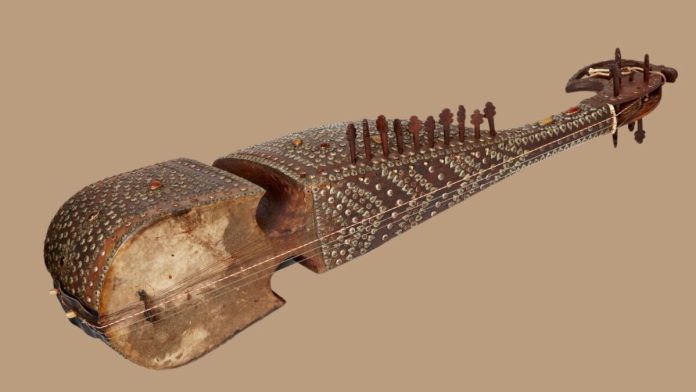- Advertisement -
PESHAWAR, Dec 12 (APP):Rabab–one of the oldest and most cherished musical instruments in Central, and Southwest Asia, has earned a significant place in the global cultural history after it was included in UNESCO’s representative list of an Intangible Cultural Heritage of Humanity.
This recognition highlighted its importance not only as a musical instrument but also as a symbol of cultural unity among people of Pakistan, Afghanistan, Iran, Tajikistan and Uzbekistan.
Lateefur Rehman, the spokesperson for the Cultural and Tourism Department KP told APP that Rabab has been included in the UNESCO representative list of an intangible cultural heritage of humanity after Mafkoora, an NGO working in research and development and Hunari Welfare Society (KP artists’ body), wrote a letter to the UNESCO Country Office in Islamabad on June 10, 2024.
He said that these organizations proposed to designate May 31 as International Rabab day keeping in view its importance in promoting peace, warmth and social cohesion in the entire region. By officially recognising the art of crafting and playing Rabab as an intangible cultural heritage, the UNESCO has acknowledged the cultural significance of this ancient musical instrument for Pakistan, Afghanistan and its neighbouring countries, including Iran, Tajikistan and Uzbekistan.
He said that inscription was approved on 4th December during the 19th session of UNESCO’s intergovernmental committee for safeguarding of the intangible cultural heritage that took place in Paraguay.
“The inclusion of the Rabab in UNESCO’s prestigious list is a testament to its rich cultural significance in music of subcontinent, south east and central asia,” Pashto Ghazal mestro and Pride of Performance, Khyal Muhammad told APP.
He said it was a matter of great pride for people of Pakistan especially for Pakhtuns that Rabab, most commonly known as the king instrument of Pashto orchestra, got official recognition at the international level.
He said that it not only featured its rich musical legacy but also its enduring role maintaining cultural identity and promoting unity across diverse communities in central asia and beyond.
“Rabab is a unifying factor among the people of the region, bringing together diverse communities through heart touching music during joyous occasions,” he told APP. Crafted from dried mulberry wood found in deserts of the region, he said that Rabab has been played for centuries in various settings, from weddings, birthday parties and celebrations to gatherings and ritual ceremonies especially in Pakthoon belt of Pakistan and Afghanistan.
He said its unique sound has found a place in orchestral and contemporary music, including multinational musical ensembles that considered success of Pashto films.
Khayal Muhammad said that Rabab has played an important role in the success of Pashto films at the box office in the past, referring to the famous Pashto film ‘Orbal’ that made record business due to its heart touching music courtesy to Rabab.
“The instrument’s role in creating a harmonious atmosphere during celebrations was undeniable, and it has become an essential part of cultural performances across subcontinent especially in Khyber Pakthunkhwa, Central Punjab and Karachi and neigbouring country of Afghanistan,” said TV famous actor, Javed Babar, a pride of performance while talking to APP.
He said that master players of Rabab are highly respected within their communities, which often play a central role in initiating happy ceremonies besides being very popular in Hujra’s culture in KP.
Dilaram Khan, a Rabab musician told APP that he inherited the art form from his late father with 25 years singing in Rabab on his credit and reiterated to pass it to his sons. The craft of making Rabab, which involves carpentry and woodcarving are typically handed down through family traditions and ensuring its continued preservation.
He said the development of declaring Rabab in UNESCO heritage list was a great breakthrough towards revival of the traditional Pashto music especially in Pakistan and Afghanistan. It was deeply woven into the fabric of local literature with many poems and myths associated with it often repeated by elders during community gatherings.
Despite odds, he said that Rabab craftsmen and players have preserved it as both tangible and intangible cultural heritage in Khyber Pakthunkhwa. Rabab lover Haider Zaman, a resident of Wapda Town Nowshera, shared his personal connection with the instrument and said, “Rabab adds colours to weddings and other joyous occasions and without it his family functions were incomplete.”
“ I have planned the marriage of my son next month and invited Rabab artists to make it a memorable event,” he said. These sentiments reflect the deep emotional bond that people of KP have with this instrument, which has become synonymous with happiness and celebrations over centuries.
As Rabab crafting is traditionally a male-dominated craft, the instrument’s performance transcends gender, with both men and women of different ethnicities and backgrounds playing it to make their functions memorable. This versatility and inclusivity allowed Rabab to remain a living tradition in the cultural fabric of the region.
Rabab’s presence in Pashto literature and poetry further underscored its cultural significance in Pakistan. Many cultures throughout the region reference the instrument in their myths and stories, passed down by elders and masters in social gatherings.
These tales not only preserve the instrument’s history but also celebrate its integral role in the lives of people across the subcontinent and beyond. The inclusion of Rabab in UNESCO recognition of world heritage is a momentous occasion for the people of Central and South Asia especially of Pakistan and Afghanistan, reaffirming the instrument’s long lasting legacy and its place in the heart of the region’s cultural heritage.

